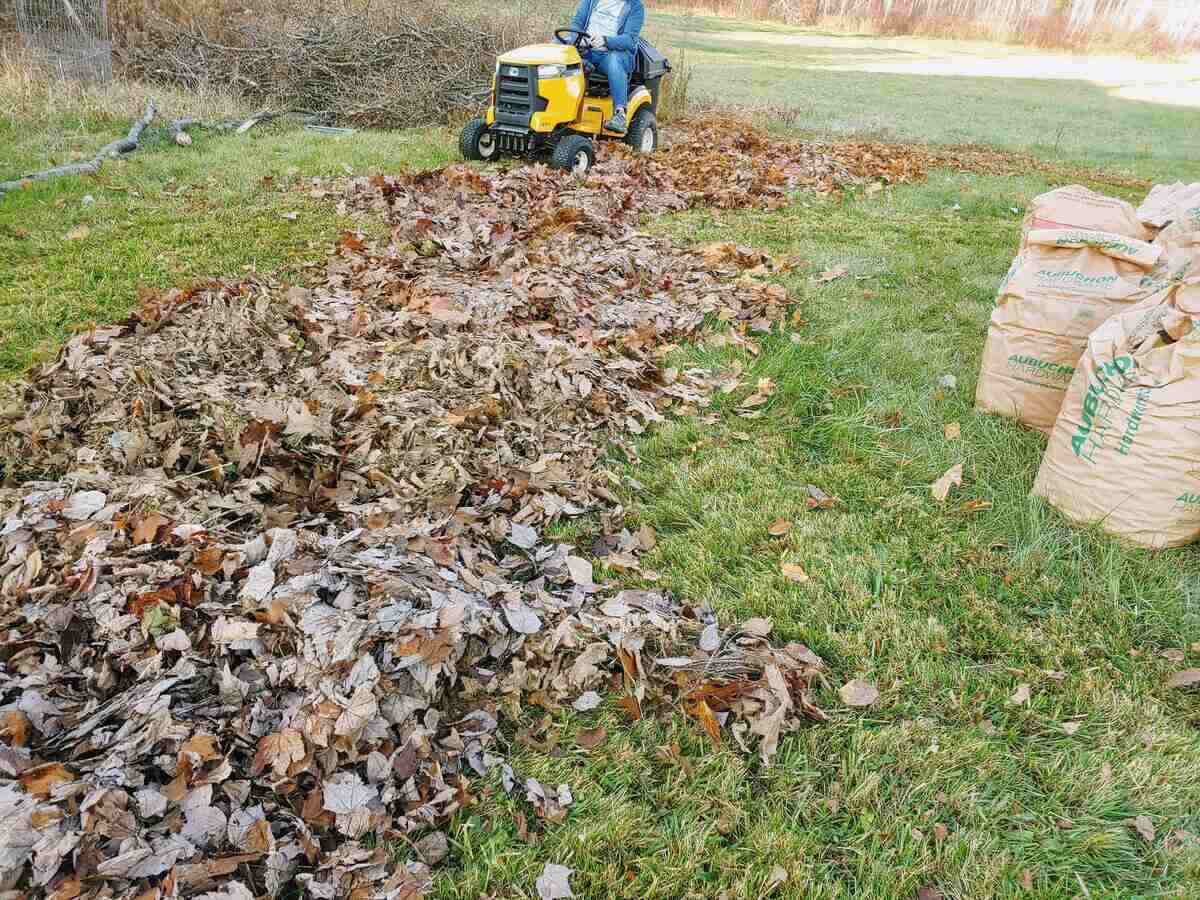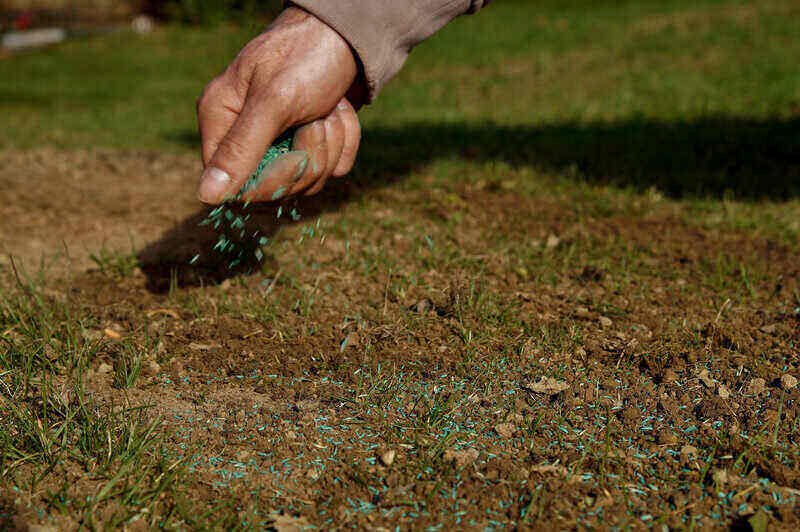
If you want to have a stellar-looking lawn in time to host an outdoor Derby party, you need to start in the fall. The fall is the best time to fertilize, overseed, and prepare your cool-season lawn for the spring to come.
Follow these tips to get your lawn in top condition:
- If it’s growing, keep mowing
- Mulch the leaves
- Aerate and dethatch, if needed
- Fertilize
- Overseed
- Consider your weeds
- Winterize your sprinklers
- Prep tools for storage
1. If it’s growing, keep mowing
After a long summer, you’re probably growing weary of your lawn mowing chores. But now is not the time to give up. Cool-season grasses such as tall fescue or Kentucky bluegrass will start to grow faster during their fall growth period while warm-season grasses start to slow down.
Whether your grass is cool-season or warm-season, keep mowing as long as the grass is still growing. How often you mow will depend on the season, but the University of Kentucky suggests keeping your grass height within these ranges throughout the year:
| Grass type | Grass height |
| Kentucky bluegrass | 2-3.5 inches |
| Perennial ryegrass | 1.5-2.5 inches |
| Tall fescue | 2-3.5 inches |
| Bermudagrass | 1-2 inches |
| Zoysiagrass | 1-3 inches |
2. Mulch the leaves

Another reason to keep up (or increase) your mowing in the fall is to mulch your leaves. If the grass doesn’t need cutting but the leaves are falling, mowing is the ideal choice because this will recycle those nutrients back into the lawn, acting as a slow-release fertilizer.
To cut the leaves finely, you’ll want to use a mulching mower or buy a mulching mower blade kit. Mulching mower blades pull the cut grass or leaves up into the deck. As the cut bits fall down, they are cut again multiple times with the two blades before they hit the ground. This helps the debris break down more quickly and doesn’t contribute to thatch in the lawn.
If the leaf coverage is over 50%, consider putting a bag on the mower and adding the chopped leaves to your compost bin or to your flower beds as mulch. If it’s under 50%, mulching the leaves into the lawn is a good practice.
Pro Tips:
- Mulch early and often. Mowing over the leaves as often as every few days may be necessary to keep up with the leaf fall.
- Mow when the leaves are dry (and wear a dust mask).
- Mow at a regular speed or a little slower for the best results. You may have to make several passes to get heavier leaf litter chopped up finely.
- In general, mow a little higher than normal, 3-4 inches high, to allow the leaf litter to fall into the grass canopy.
- A sharp mower blade will make the job much easier and provide a finer leaf mulch. (See Tip #8)
3. Aerate and dethatch, if needed

According to the University of Kentucky Extension service, aerating and dethatching your lawn may not be necessary each year. So, how do you know whether this is necessary for your lawn or not?
Here are a few questions to ask yourself:
- Does your lawn get a lot of foot traffic?
- Do you live in a newly constructed neighborhood?
- Do you mow with heavy mowing equipment?
- Does your soil have a high clay content?
- What is your grass type?
- Kentucky bluegrass and bermudagrass produce thatch more easily. Tall fescue and perennial ryegrasses are bunch-type grasses, which don’t usually produce thatch. Zoysia also produces thatch, but since it’s so slow to recover, dethatching is not usually recommended.
Answering yes to the first four questions means that your soil may be at a higher risk of compaction. Grass type and overfertilization can contribute to heavy thatch problems. Here are two simple ways to get a closer look at your compaction or thatch levels:
- Here’s a simple test for determining your soil compaction: If you can insert a knife into the soil with just the pressure from your thumb, you probably don’t need to aerate this year.
- Check your thatch level by taking a sample from the grass with a spade or trowel. If the thatch layer (the layer of material between the grass and soil) is greater than ½ inch, you may want to consider dethatching.
Remember, only aerate or dethatch when the lawn is actively growing. For cool-season lawns, this happens in the fall or spring. For warm-season lawns, the early to mid-summer season is the period of most active growth.
4. Fertilize
First things first: You won’t know what your lawn needs, if anything, unless you do a soil test. Your local Jefferson County Cooperative Extension Office will send off your soil test for a nominal fee. Here’s how to collect a soil sample from your lawn:
- Take about 10-15 samples with a soil probe or spade. Go to a depth of 3-4 inches. Collect samples from the entire lawn area.
- Remove any grass or dead vegetation from the top. Mix the samples in a plastic bucket.
- If the soil is damp, spread it out on a brown paper bag overnight to dry.
- Bring at least 2 cups of soil to your Extension Office.
- Fill out the form and wait patiently for the results.
Home lawns only need to be sampled once every three to five years. Be sure to take separate samples from areas with different soils, such as garden or flower beds.
Once you get the results, you’ll have a complete picture of the nutrient levels in your lawn (kind of like a blood test). Now you can rest assured you’re giving your lawn just what it needs, which is a win for your lawn and your wallet.
When to fertilize and how much
Most homeowners have low- or medium-maintenance lawns, meaning you choose to irrigate seldom or never and fertilize only once or twice per year. Follow these recommendations from the University of Kentucky for how much and how often to fertilize a low- to medium-maintenance lawn:
| Type of grass | Level of maintenance | When to fertilize | How much to fertilize per application |
| Cool-season (tall fescue, Kentucky bluegrass, perennial ryegrass) | Low (no irrigation, no foot traffic, large acreage) | Once per year – October | 1 pound of nitrogen per 1,000 square feet |
| Cool-season | Medium (only irrigate during droughts, may have high foot traffic, smaller area common to home or apartment lawns) | Twice per year – October and November | 1 pound of nitrogen per 1,000 square feet |
For warm-season grasses such as bermuda and zoysia, wait until summer to apply fertilizer. Bermuda likes three or four applications of nitrogen in the summer (1 pound of nitrogen per 1,000 square feet per application). Zoysia only needs one or two applications (using the same rate of application as bermuda). Divide the applications evenly over the three-month summer period (end of June through the end of September).
5. Overseed
If your turf-type tall fescue, Kentucky bluegrass, or other cool-season grass has suffered summer stress, mid-August to late September is the time to overseed. (Sorry, warm-season lawns, you’ll have to wait until late spring or early summer.)
Follow these simple steps to overseed your cool-season lawn:
- Rent a dethatcher and dethatch the lawn. This machine makes grooves in the lawn and ensures good seed to soil contact.
- Apply phosphorus or potassium if your soil test recommends it. If your soil test recommends nitrogen, wait until after the grass germinates to apply.
- You also can apply compost at this point to improve the organic matter in your soil.
- Broadcast the seed using a hand-held or push spreader. Go over the lawn vertically and then again horizontally for the best coverage. (Be sure to use only half of your seed for the first pass if you’re making two passes across the lawn.)
- Use the back of a rake to push the seed gently into the soil.
- If you didn’t add compost earlier, add a thin layer of topsoil at this point.
- Water once or twice daily until it’s established.
6. Consider your weeds
What is the best defense against weeds? A healthy, thick lawn. A full lawn cut at the right height helps shade out weed seeds and provides competition to undesirable weeds.
If you follow the cultural practices in this list, your lawn will be less susceptible to weeds because you’ll be promoting a thick stand of grass. How? By mowing at the proper height, mulching in the grass clippings and leaf litter, aerating and dethatching as needed, fertilizing, and filling in thin patches with new grass seed.
Even if you do all these things, you’ll still have some weeds. Most experts recommend chemicals as a last resort, though, so consider hand-pulling or using an organic option.
Alternatively, you could learn to love weeds like white clover. White clover acts as a natural fertilizer by providing nitrogen to the soil. A full clover lawn naturally provides about 2 pounds of nitrogen per 1,000 square feet per year, which is the recommendation for synthetic nitrogen fertilizer in a normal lawn. In addition, white clover provides an important source of urban forage for bees and other pollinators.
If you have a larger infestation or are interested in exploring chemical methods, September or October is the time to use a broadleaf granular post-emergent in your lawn. You also can spot treat broadleaf weeds from November through January.
7. Winterize your sprinklers

If you have a sprinkler system, upkeep is a three-season proposition. You start the system in the spring, have it checked during peak use in the summer, and have it shut down for the winter late in the year.
If you have an annual sprinkler contract, they may call you to set up your winter maintenance appointment. If not, call them ahead of time to avoid the winter rush. Plan to have this done when the temperatures start to dip below 40 degrees or when the grass becomes dormant.
When they come for the appointment, ask them to check the components to ensure everything is in working order and blow out all the water from the system.
8. Prep tools for storage

Once you’ve finished mowing for the season, give your future (spring) self a head start by sharpening your mowing blade.
If that sounds like a job for the experts, take your blade to a local lawn mower repair shop to have your blade sharpened for a nominal fee.
If you’d like to try it yourself, it’s simple; here’s how:
- Disconnect the spark plug wire.
- Remove the bolt that holds the blade in place underneath the deck.
- Place the blade in a vice and use a file to sharpen the edge. Or, you can use a bench grinder. Be sure to maintain the angle of the blade no matter which method you use.
- Hang the blade from a nail to make sure it hangs level.
- Before you replace the blade, use a putty knife or pressure washer to clean the underside of the mower deck.
- Replace the blade and reattach the spark plug.
- Enjoy knowing this chore is done, and you’re ready for spring.
If you’d rather spend your fall weekends enjoying a production by Kentucky Shakespeare or playing pickleball at E.P. “Tom” Sawyer State Park, let our Louisville lawn care professionals take fall lawn care off your weekend to-do list.
Main Photo Credit: sk | Flickr | CC BY-ND 2.0
